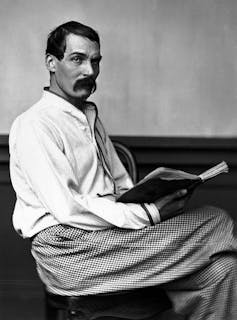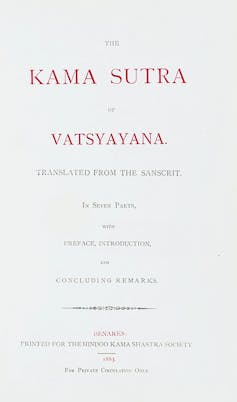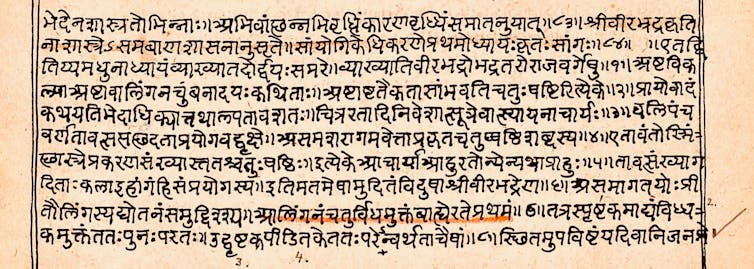Sharha, Cardiff Metropolitan University
For some people, the Kamasutra is little more than a name associated with condom brands, scented oils and chocolates shaped into erotic positions. In India, where sex remains a taboo subject, this ancient sex manual has often been reduced to merely a “dirty book”.
But beneath this narrow view lies a deeper message: the Kamasutra is a treatise on sexual autonomy, one that could be revolutionary for women.
In Indian society, women’s sexual pleasure is often invisible, buried beneath layers of cultural silence. Women are often taught to suppress their desires, their voices stifled by traditions that prioritise male needs. Yet, it was in this very country that the Kamasutra was written.
Composed in the ancient Sanskrit language in the 3rd century by the Indian philosopher Vatsyayana, the Kamasutra is more than a book about sexual positions. The word “kama” means love, sex, desire and pleasure, while “sutra” translates to a treatise. The text explores relationships, ethics and social norms. It offers a framework for mutual respect and understanding between partners.
In her 2016 book Redeeming the Kamasutra, scholar of Indian culture and society Wendy Doniger argues that Vatsyayana was an advocate of women’s pleasure as well as stressing their right to education and the freedom to express desire. Far from reinforcing male dominance, the Kamasutra originally emphasised the importance of mutual enjoyment and consent. It presents sex as a shared experience rather than a male conquest.

The perception of the Kamasutra as a male-centred sex manual can be traced back to its first English translation by Sir Richard Burton in 1883.
Burton, a British soldier and explorer, omitted or altered passages that highlighted women’s autonomy. It shifted their role from active participants to passive recipients of male pleasure.
In contrast, scholars such as Ganesh Saili have argued that the Kamasutra originally depicted women as equal partners in intimacy. According to the text, women communicated their needs through gestures, emotions and words, ensuring that their pleasure was just as valued as men’s. Importantly, conversation played a central role in intimacy, reinforcing the necessity of a woman’s consent before having sex.
Despite this rich history, Indian society continues to largely suppress discussions around female sexuality. Indian sex educator and journalist Leeza Mangaldas argues that women’s sexual pleasure remains a taboo topic, policed by cultural expectations that dictate women must remain silent, subservient and sexually inactive before marriage.
Social scientist, Deepa Narayan, argues that this suppression begins at home. Girls are often taught to deny their own bodies and prioritise male desires.

This control extends to patriarchal social norms that uphold virginity as a virtue for women while imposing no such expectation on men. Sex is framed as something women “give” rather than something they experience. Pleasure is seen as a right for males but merely an afterthought for females. Sex is for men but for women, it is only for producing babies.
Yet the Kamasutra itself tells a different story. In its original form, it described women as active participants in their pleasure and compared their sensuality to the delicacy of flowers – requiring care, attention and respect.
My own research explores “Kamasutra feminism”. This is the idea that this ancient text is not just about sex but about sexual autonomy. It challenges patriarchal norms by promoting women’s freedom to articulate their desires and take control of their pleasure. The Kamasutra rejects the notion that women’s sexuality should be regulated or repressed. Instead, it advocates for mutual satisfaction and consent.
Doniger describes the Kamasutra as a feminist text, citing its emphasis on women choosing their partners, expressing their desires freely and engaging in pleasurable sexual relationships. It recognises economic independence as a crucial factor in women’s sexual autonomy. Financial freedom is linked to the ability to make personal choices.

Patriarchy versus sexual liberty
Ultimately, the Kamasutra represents a clash between patriarchy – where women’s sexuality is controlled – and a vision of sexual liberty. It offers an alternative narrative, one where seduction is about mutual enjoyment rather than male domination. Its teachings encourage open discussions about intimacy, allowing women to reclaim their voices in relationships.
For more than a century, the Kamasutra has been misinterpreted, its radical message buried beneath layers of censorship and cultural shame. But if we look beyond its erotic reputation, we find a text that speaks to the importance of consent, equality and female agency.
Reclaiming the Kamasutra as a guide for sexual empowerment could help dismantle deeply ingrained taboos and reshape the conversation around women’s pleasure. In a world where female desire is still widely policed, this ancient manuscript reminds us that women’s pleasure is not a luxury, but a right.
Sharha, PhD Candidate in Kamasutra Feminism, Cardiff Metropolitan University
This article is republished from The Conversation under a Creative Commons license. Read the original article.











